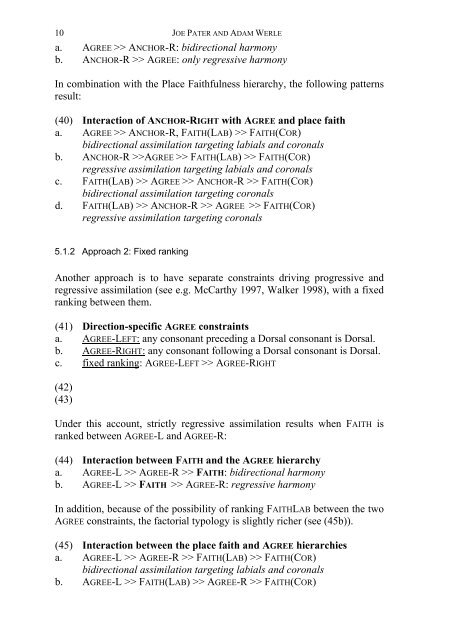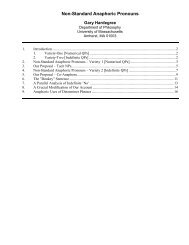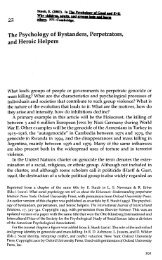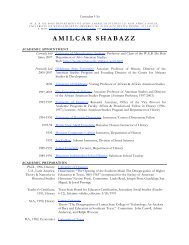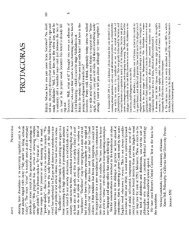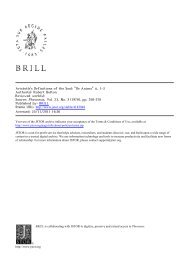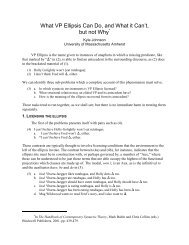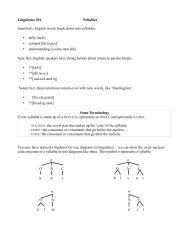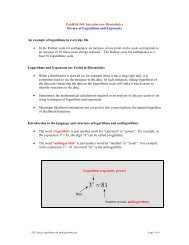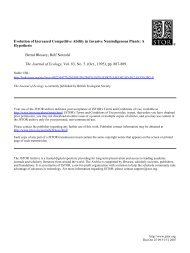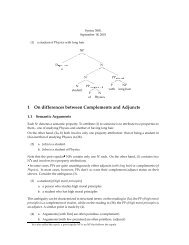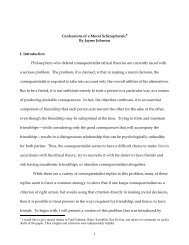Typology and variation in child consonant harmony - University of ...
Typology and variation in child consonant harmony - University of ...
Typology and variation in child consonant harmony - University of ...
You also want an ePaper? Increase the reach of your titles
YUMPU automatically turns print PDFs into web optimized ePapers that Google loves.
10 JOE PATER AND ADAM WERLE<br />
a. AGREE >> ANCHOR-R: bidirectional <strong>harmony</strong><br />
b. ANCHOR-R >> AGREE: only regressive <strong>harmony</strong><br />
In comb<strong>in</strong>ation with the Place Faithfulness hierarchy, the follow<strong>in</strong>g patterns<br />
result:<br />
(40) Interaction <strong>of</strong> ANCHOR-RIGHT with AGREE <strong>and</strong> place faith<br />
a. AGREE >> ANCHOR-R, FAITH(LAB) >> FAITH(COR)<br />
bidirectional assimilation target<strong>in</strong>g labials <strong>and</strong> coronals<br />
b. ANCHOR-R >>AGREE >> FAITH(LAB) >> FAITH(COR)<br />
regressive assimilation target<strong>in</strong>g labials <strong>and</strong> coronals<br />
c. FAITH(LAB) >> AGREE >> ANCHOR-R >> FAITH(COR)<br />
bidirectional assimilation target<strong>in</strong>g coronals<br />
d. FAITH(LAB) >> ANCHOR-R >> AGREE >> FAITH(COR)<br />
regressive assimilation target<strong>in</strong>g coronals<br />
5.1.2 Approach 2: Fixed rank<strong>in</strong>g<br />
Another approach is to have separate constra<strong>in</strong>ts driv<strong>in</strong>g progressive <strong>and</strong><br />
regressive assimilation (see e.g. McCarthy 1997, Walker 1998), with a fixed<br />
rank<strong>in</strong>g between them.<br />
(41) Direction-specific AGREE constra<strong>in</strong>ts<br />
a. AGREE-LEFT: any <strong>consonant</strong> preced<strong>in</strong>g a Dorsal <strong>consonant</strong> is Dorsal.<br />
b. AGREE-RIGHT: any <strong>consonant</strong> follow<strong>in</strong>g a Dorsal <strong>consonant</strong> is Dorsal.<br />
c. fixed rank<strong>in</strong>g: AGREE-LEFT >> AGREE-RIGHT<br />
(42)<br />
(43)<br />
Under this account, strictly regressive assimilation results when FAITH is<br />
ranked between AGREE-L <strong>and</strong> AGREE-R:<br />
(44) Interaction between FAITH <strong>and</strong> the AGREE hierarchy<br />
a. AGREE-L >> AGREE-R >> FAITH: bidirectional <strong>harmony</strong><br />
b. AGREE-L >> FAITH >> AGREE-R: regressive <strong>harmony</strong><br />
In addition, because <strong>of</strong> the possibility <strong>of</strong> rank<strong>in</strong>g FAITHLAB between the two<br />
AGREE constra<strong>in</strong>ts, the factorial typology is slightly richer (see (45b)).<br />
(45) Interaction between the place faith <strong>and</strong> AGREE hierarchies<br />
a. AGREE-L >> AGREE-R >> FAITH(LAB) >> FAITH(COR)<br />
bidirectional assimilation target<strong>in</strong>g labials <strong>and</strong> coronals<br />
b. AGREE-L >> FAITH(LAB) >> AGREE-R >> FAITH(COR)


